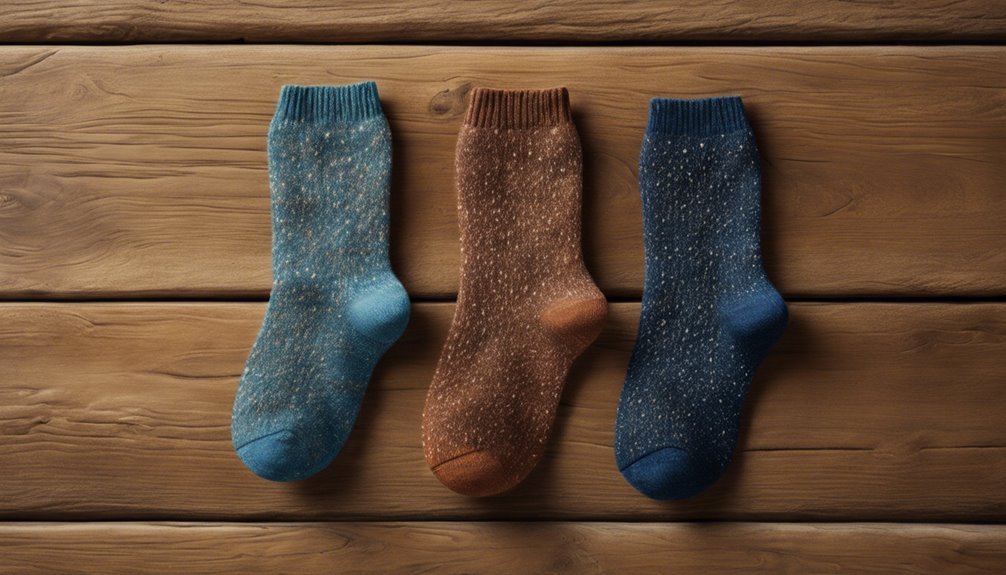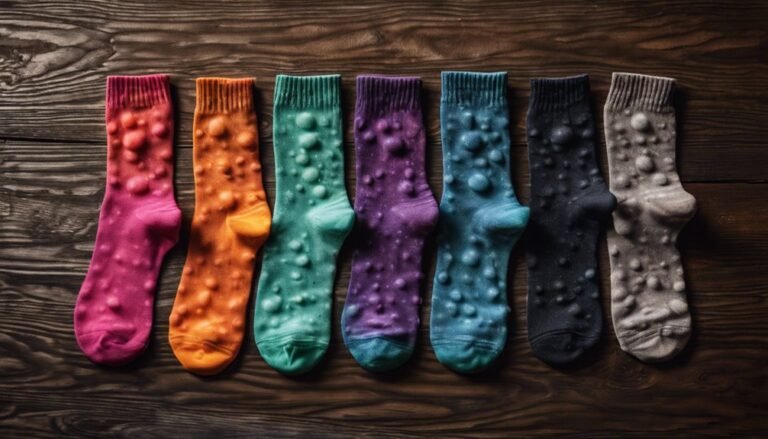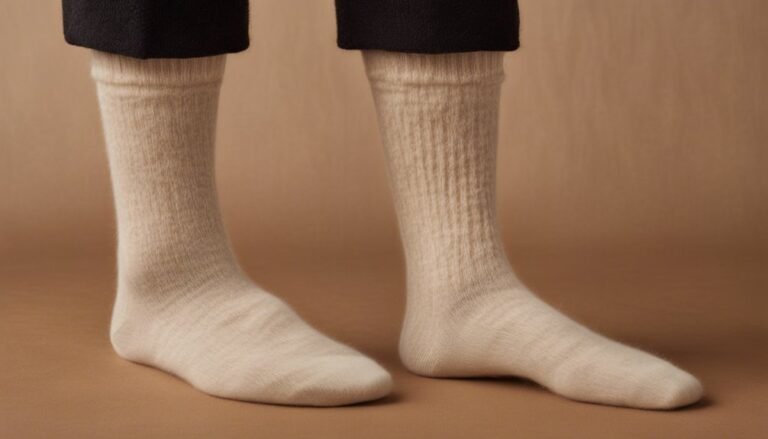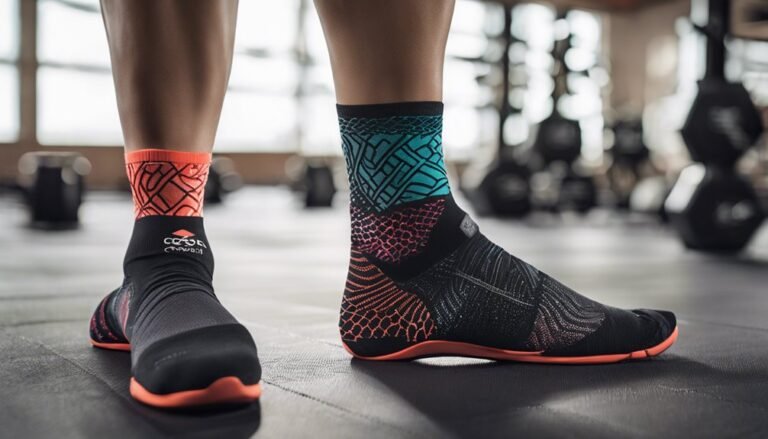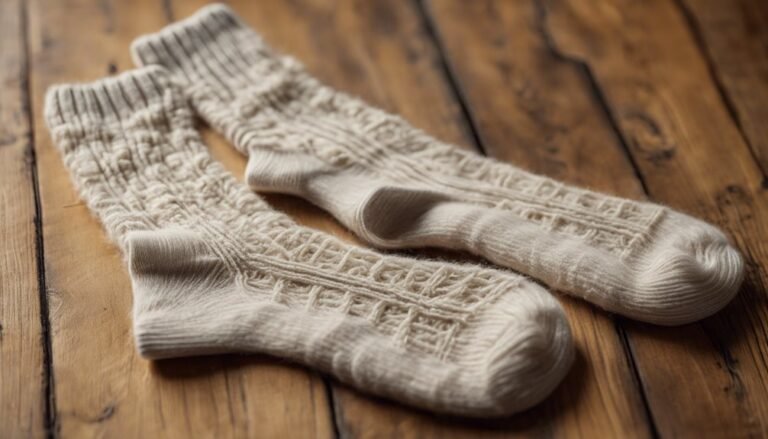Moisture-Wicking Socks: Merino Wool vs. Synthetic Materials
When choosing moisture-wicking socks, Merino wool offers excellent temperature regulation, natural odor resistance, and superior moisture management, making it ideal for prolonged wear. In contrast, synthetic materials excel in quick-drying properties, lightweight design, and durability under heavy use. The best option depends on your activity level and conditions; thicker cushioning benefits hiking, while lighter options are great for cycling. Explore further to understand the nuances that influence your sock choice and performance benefits.
Understanding Moisture-Wicking Technology
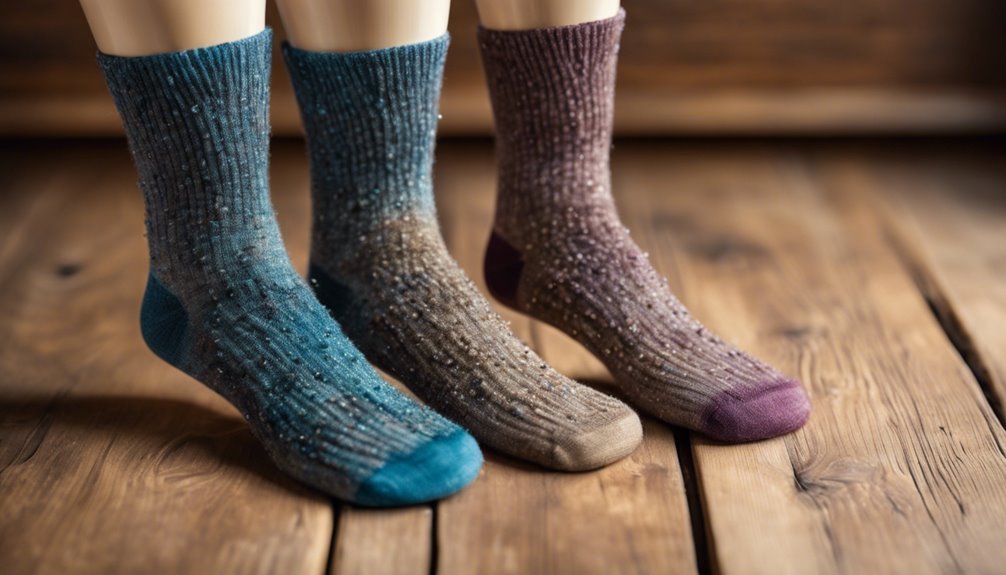
While you might think that all socks are created equal, understanding moisture-wicking technology reveals significant differences that can affect your comfort and performance. Moisture control is essential for maintaining a dry environment for your feet during physical activities. Advanced fabric technology allows specific materials to draw sweat away from your skin, transporting it to the surface, where it evaporates. This process not only keeps your feet dry but also helps regulate temperature, preventing discomfort from overheating. Synthetic fibers, such as polyester and nylon, often excel in moisture-wicking capabilities due to their hydrophobic properties. In contrast, natural fibers may struggle to provide the same level of moisture management. Ultimately, selecting the right sock involves recognizing the importance of effective moisture control for your specific needs.
The Benefits of Merino Wool
When it comes to moisture-wicking performance, Merino wool stands out as a superior natural fiber option. This remarkable material offers several key benefits that enhance your experience during activities.
- Temperature Regulation: Merino wool effectively manages body heat, keeping you comfortable in both warm and cool conditions.
- Natural Insulation: The fiber's structure traps air, providing warmth without bulk, perfect for maintaining comfort during varying intensities.
- Odor Resistance: Unlike synthetic fibers, Merino wool naturally resists odors, allowing you to wear your socks longer without unpleasant smells.
The Advantages of Synthetic Fabrics
When considering moisture-wicking socks, synthetic fabrics offer distinct advantages that can enhance your experience. Their quick-drying properties guarantee you stay comfortable during intense activities, while being lightweight and breathable prevents overheating. Additionally, the durability and flexibility of synthetic materials make them a reliable choice for various conditions.
Quick-Drying Properties
Although many outdoor enthusiasts appreciate the natural properties of Merino wool, synthetic materials have a distinct advantage in quick-drying capabilities. When you're out in the elements, drying efficiency matters greatly. Synthetic fabrics employ advanced quick drying techniques that allow them to shed moisture rapidly, ensuring your feet stay dry and comfortable.
Here are three key benefits of synthetic materials in quick-drying properties:
- Moisture Management: They pull sweat away from your skin, promoting evaporation.
- Lightweight Composition: Less mass means quicker drying times compared to heavier alternatives.
- Durability: Synthetic fibers resist degradation from moisture, maintaining performance over time.
For those seeking freedom in their outdoor adventures, quick-drying socks can make all the difference.
Lightweight and Breathable
Lightweight and breathable, synthetic fabrics offer significant advantages for outdoor enthusiasts. When you're trekking or engaging in high-energy activities, the significance of breathable fabrics can't be overstated. These lightweight materials reduce bulk, allowing for freedom of movement without sacrificing comfort. Their engineered design promotes airflow, keeping your feet cool and minimizing sweat accumulation. Unlike heavier alternatives, synthetic options dry quickly, preventing the uncomfortable cling of moisture. This is vital in maintaining a fresh feeling during extended wear. Additionally, many synthetic socks feature mesh zones that enhance breathability, actively regulating temperature. By prioritizing lightweight and breathable fabrics, you'll guarantee your feet remain dry and comfortable, enabling you to focus on the adventure ahead.
Durability and Flexibility
While many outdoor enthusiasts prioritize comfort, it's essential not to overlook the durability and flexibility that synthetic fabrics provide. These materials are engineered for long-lasting performance, ensuring your socks withstand the rigors of various activities. Here's why synthetic options shine:
- Flexible Design: Synthetic fabrics often incorporate stretchable fibers, allowing for a snug fit that moves with you.
- Enhanced Resilience: They resist wear and tear, maintaining their integrity through repeated use.
- Quick Drying: Unlike natural fibers, synthetics dry rapidly, keeping your feet comfortable and reducing the risk of blisters.
Choosing synthetic moisture-wicking socks means investing in a reliable companion for your outdoor adventures, giving you the freedom to explore without concerns about durability.
Comparing Moisture Management
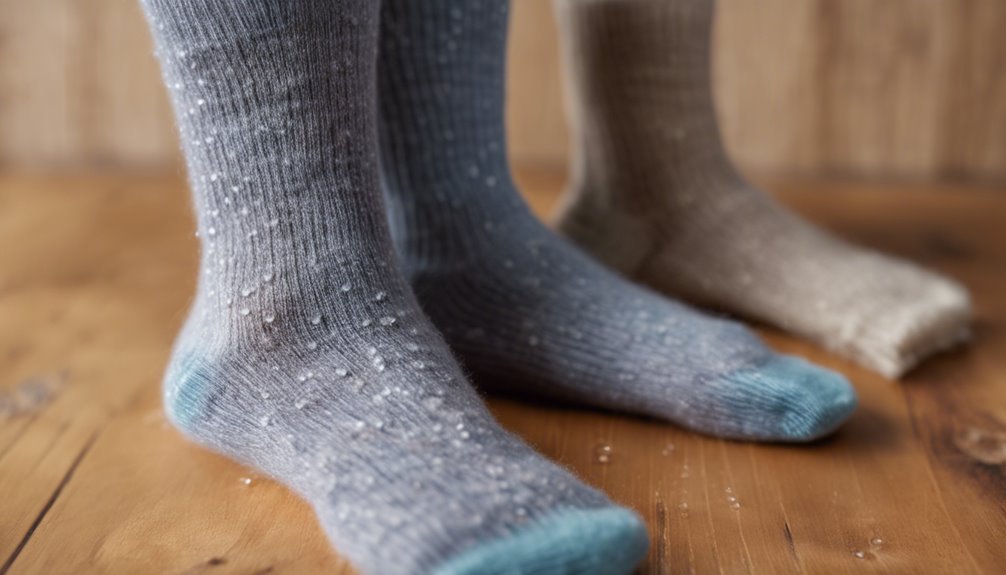
When evaluating moisture management in socks, it is crucial to compare the absorption capacity of Merino wool against synthetic materials. You'll notice significant differences in how quickly each type dries, impacting overall comfort during wear. Understanding these factors will help you choose the right sock for your needs.
Absorption Capacity Comparison
Although moisture management is a critical factor in sock performance, the absorption capacity of materials can vary considerably. When evaluating absorption efficiency, consider the following key aspects:
- Merino Wool: Known for its high moisture retention, it can absorb up to 30% of its weight in moisture without feeling wet, making it ideal for prolonged wear.
- Synthetic Materials: Typically engineered for quick-drying capabilities, they may lack the same level of moisture retention, often making them feel clammy when saturated.
- Hybrid Options: Combining Merino wool with synthetic fibers offers a balance, enhancing both absorption efficiency and moisture management.
Drying Speed Analysis
In evaluating the drying speed of moisture-wicking socks, it is vital to recognize how different materials respond to moisture accumulation. Merino wool, while excellent at absorbing moisture, tends to retain it longer compared to synthetic materials, which excel in quick drying due to their hydrophobic properties. In ideal drying environments, such as warm and ventilated spaces, synthetics can dry considerably faster, often within hours. Conversely, Merino may take longer to reach a dry state, especially in humid settings. Understanding these drying techniques is essential for maximizing comfort and performance during activities. If you prioritize rapid moisture removal and quick drying, synthetic options may be your best bet, especially in variable conditions.
Comfort and Fit: A Material Comparison
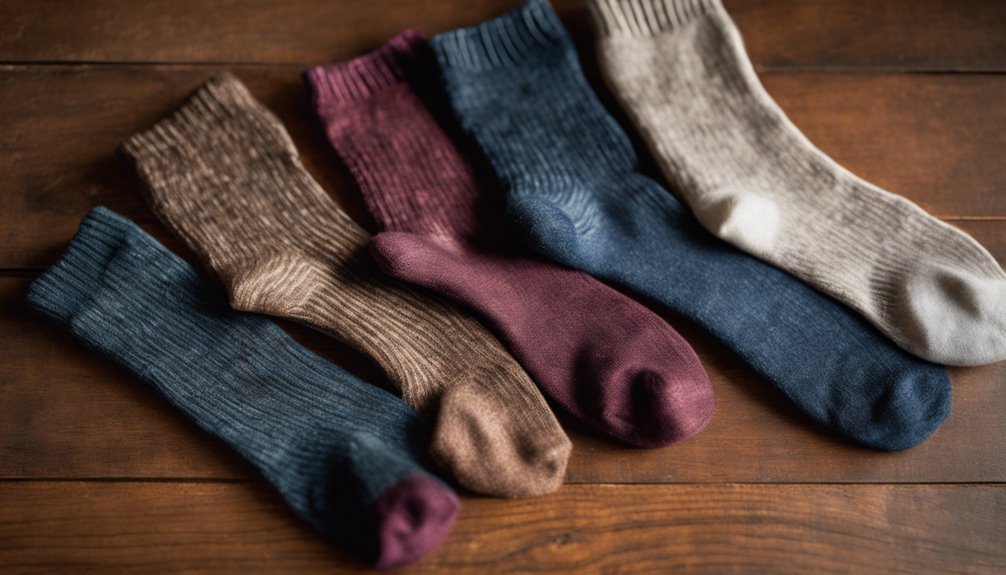
While the choice between Merino wool and synthetic materials often hinges on personal preference, understanding their respective comfort and fit characteristics is essential. Both materials cater to different fit preferences and sock thickness, impacting your overall experience.
- Merino Wool: Known for its softness, it molds to your foot shape and offers excellent insulation.
- Synthetic Materials: Typically lighter, they can provide a snug fit that reduces bulk, ideal for those who prefer a thinner sock.
- Temperature Regulation: Merino excels in temperature control, while synthetics often prioritize moisture management.
Ultimately, your fit preference will dictate whether you lean towards the luxurious feel of Merino wool or the sleek design of synthetic socks. Choose wisely, as your comfort is paramount.
Durability and Longevity
When considering comfort and fit, it's also important to evaluate how these materials hold up over time. Merino wool offers natural resilience against wear and tear, often lasting longer than synthetic options due to its ability to maintain structure and resist odors. However, synthetic materials can excel in durability, especially when engineered for heavy-duty use. They typically withstand rigorous activities without losing functionality.
To maximize longevity, follow maintenance tips specific to each material. For merino wool, hand-washing in cool water and air-drying helps preserve fibers. Synthetic socks may tolerate machine washing, but avoid high heat to prevent degradation. Ultimately, your choice will depend on your activity level and maintenance commitment, ensuring you enjoy the freedom of long-lasting performance.
Environmental Impact of Each Material
Although both merino wool and synthetic materials offer performance benefits, their environmental impacts differ considerably. Merino wool typically comes from sheep that are often sustainably sourced, promoting biodiversity and reducing land degradation. In contrast, synthetic materials are derived from petroleum, boasting a higher carbon footprint due to extraction and processing.
Consider these key points:
- Sustainable Sourcing: Merino wool supports ethical farming practices, while synthetic fibers lack similar transparency.
- Carbon Footprint: The production of synthetic socks generates more greenhouse gases compared to wool.
- Biodegradability: Merino wool decomposes naturally, reducing landfill waste, unlike synthetic materials that persist for decades.
These factors can influence your choice, aligning your sock selection with your environmental values.
Cost Considerations
As you consider moisture-wicking socks, cost can be a significant factor influencing your decision. Conducting a thorough cost analysis is essential to understand how Merino wool and synthetic materials fit into your budget considerations. Merino wool socks typically come with a higher price tag due to their natural properties and durability, often providing superior comfort and moisture management. However, synthetic options are usually more affordable and can still perform well under various conditions. When weighing your choices, consider the long-term value of your investment. Higher-quality socks may reduce the need for replacements and provide better performance over time, ultimately impacting your overall cost-effectiveness. Balancing initial costs with performance longevity can lead to more informed purchasing decisions.
Choosing the Right Sock for Your Activity
How do you select the right sock for your specific activity? Proper sock selection strategies can greatly enhance your comfort and performance. Consider these activity-specific features when choosing:
- Material Composition: Opt for Merino wool for insulation and moisture control during cool-weather activities, or synthetic fibers for breathability during high-intensity workouts.
- Cushioning Level: Choose thicker cushioning for hiking or running to absorb impact, while lighter cushioning works well for casual wear or cycling.
- Height and Fit: Select crew or knee-high socks for added protection during rugged hikes, and ankle or no-show socks for a minimalist feel in casual settings.
Frequently Asked Questions
Can Moisture-Wicking Socks Help Prevent Blisters During Long Hikes?
Studies show 70% of hikers experience blisters. Moisture-wicking socks, made from specific sock materials, greatly enhance blister prevention by reducing friction and keeping feet dry, making them essential for long hikes in various conditions.
How Should I Care for Moisture-Wicking Socks?
To care for your moisture-wicking socks, prioritize sock washing with gentle detergents. Avoid fabric softeners, as they can reduce wicking ability. Always air dry to maintain peak performance and extend the lifespan of your socks.
Are Moisture-Wicking Socks Suitable for Sensitive Skin?
If you've ever felt the sting of discomfort, moisture-wicking socks can provide sensitive skin benefits. However, consider material allergy considerations; choose carefully to guarantee your feet remain comfortable and irritation-free during any adventure.
What Is the Lifespan of Moisture-Wicking Socks?
The lifespan of moisture-wicking socks varies based on material longevity and durability comparison. Generally, synthetic options may last longer, but natural fibers like Merino wool can offer comfort and performance, potentially offsetting shorter lifespans.
Can I Wear Moisture-Wicking Socks in Cold Weather?
In cold weather, moisture-wicking socks can be your warmest ally. Their cold weather performance shines when paired with sock layering techniques, ensuring warmth while effectively managing moisture, keeping your feet comfortable and dry in frigid conditions.

